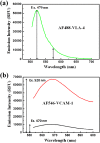The interaction affinity between vascular cell adhesion molecule-1 (VCAM-1) and very late antigen-4 (VLA-4) analyzed by quantitative FRET
- PMID: 25793408
- PMCID: PMC4368157
- DOI: 10.1371/journal.pone.0121399
The interaction affinity between vascular cell adhesion molecule-1 (VCAM-1) and very late antigen-4 (VLA-4) analyzed by quantitative FRET
Abstract
Very late antigen-4 (VLA-4), a member of integrin superfamily, interacts with its major counter ligand vascular cell adhesion molecule-1 (VCAM-1) and plays an important role in leukocyte adhesion to vascular endothelium and immunological synapse formation. However, irregular expressions of these proteins may also lead to several autoimmune diseases and metastasis cancer. Thus, quantifying the interaction affinity of the VCAM-1/VLA-4 interaction is of fundamental importance in further understanding the nature of this interaction and drug discovery. In this study, we report an 'in solution' steady state organic fluorophore based quantitative fluorescence resonance energy transfer (FRET) assay to quantify this interaction in terms of the dissociation constant (Kd). We have used, in our FRET assay, the Alexa Fluor 488-VLA-4 conjugate as the donor, and Alexa Fluor 546-VCAM-1 as the acceptor. From the FRET signal analysis, Kd of this interaction was determined to be 41.82 ± 2.36 nM. To further confirm our estimation, we have employed surface plasmon resonance (SPR) technique to obtain Kd = 39.60 ± 1.78 nM, which is in good agreement with the result obtained by FRET. This is the first reported work which applies organic fluorophore based 'in solution' simple quantitative FRET assay to obtain the dissociation constant of the VCAM-1/VLA-4 interaction, and is also the first quantification of this interaction. Moreover, the value of Kd can serve as an indicator of abnormal protein-protein interactions; hence, this assay can potentially be further developed into a drug screening platform of VLA-4/VCAM-1 as well as other protein-ligand interactions.
Conflict of interest statement
Figures






Similar articles
-
FRET based quantification and screening technology platform for the interactions of leukocyte function-associated antigen-1 (LFA-1) with intercellular adhesion molecule-1 (ICAM-1).PLoS One. 2014 Jul 17;9(7):e102572. doi: 10.1371/journal.pone.0102572. eCollection 2014. PLoS One. 2014. PMID: 25032811 Free PMC article.
-
Role of VLA-4 in the development of allergic conjunctivitis in mice.Mol Vis. 2006 Apr 7;12:310-7. Mol Vis. 2006. PMID: 16617298
-
High affinity very late antigen-4 subsets expressed on T cells are mandatory for spontaneous adhesion strengthening but not for rolling on VCAM-1 in shear flow.J Immunol. 1999 Jan 15;162(2):1084-95. J Immunol. 1999. PMID: 9916737
-
Breast cancer metastasis: Putative therapeutic role of vascular cell adhesion molecule-1.Cell Oncol (Dordr). 2017 Jun;40(3):199-208. doi: 10.1007/s13402-017-0324-x. Epub 2017 May 22. Cell Oncol (Dordr). 2017. PMID: 28534212 Review.
-
Contribution of very late antigen-4 (VLA-4) integrin to cancer progression and metastasis.Cancer Metastasis Rev. 2015 Dec;34(4):575-91. doi: 10.1007/s10555-014-9545-x. Cancer Metastasis Rev. 2015. PMID: 25564456 Review.
Cited by
-
Modulating donor mitochondrial fusion/fission delivers immunoprotective effects in cardiac transplantation.Am J Transplant. 2022 Feb;22(2):386-401. doi: 10.1111/ajt.16882. Epub 2021 Nov 8. Am J Transplant. 2022. PMID: 34714588 Free PMC article.
-
Targeting endothelial vascular cell adhesion molecule-1 in atherosclerosis: drug discovery and development of vascular cell adhesion molecule-1-directed novel therapeutics.Cardiovasc Res. 2023 Oct 24;119(13):2278-2293. doi: 10.1093/cvr/cvad130. Cardiovasc Res. 2023. PMID: 37595265 Free PMC article. Review.
-
Inflammatory Mechanisms Contributing to Endothelial Dysfunction.Biomedicines. 2021 Jul 6;9(7):781. doi: 10.3390/biomedicines9070781. Biomedicines. 2021. PMID: 34356845 Free PMC article. Review.
-
Advanced FRET normalization allows quantitative analysis of protein interactions including stoichiometries and relative affinities in living cells.Sci Rep. 2019 Jun 3;9(1):8233. doi: 10.1038/s41598-019-44650-0. Sci Rep. 2019. PMID: 31160659 Free PMC article.
-
Development of Biotinylated Liposomes Encapsulating Metformin for Therapeutic Targeting of Inflammation-Based Diseases.Pharmaceutics. 2024 Feb 5;16(2):235. doi: 10.3390/pharmaceutics16020235. Pharmaceutics. 2024. PMID: 38399288 Free PMC article.
References
-
- Oppenheimer-Marks N, Davis LS, Bogue DT, Ramberg J, Lipsky PE. Differential utilization of ICAM-1 and VCAM-1 during the adhesion and transendothelial migration of human T lymphocytes. J Immunol. 1991; 147: 2913–2921. - PubMed
-
- Weber C, Springer TA. Interaction of very late antigen-4 with VCAM-1 supports transendothelial chemotaxis of monocytes by facilitating lateral migration. J Immunol. 1998; 161: 6825–6834. - PubMed
-
- Ding Z, Xiong K, Issekutz TB. Chemokines stimulate human T lymphocyte transendothelial migration to utilize VLA-4 in addition to LFA-1. J Leukoc Biol. 2001; 69: 458–466. - PubMed
-
- Clark EA, Brugge JS. Integrins and signal transduction pathways: the road taken. Science. 1995; 268: 233–239. - PubMed
Publication types
MeSH terms
Substances
LinkOut - more resources
Full Text Sources
Other Literature Sources
Miscellaneous

